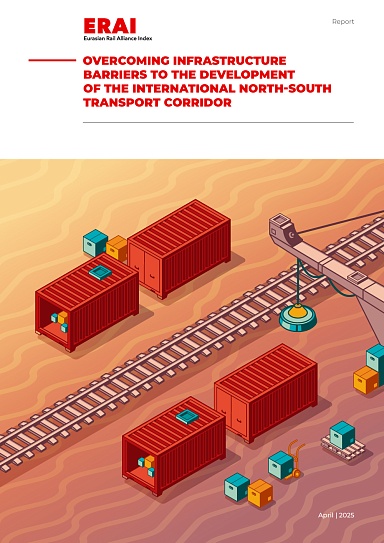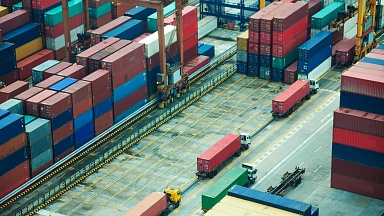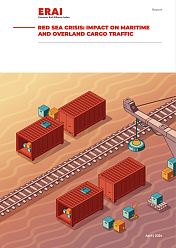In 2024, the volume of transportation along the INSTC demonstrated 19% growth and amounted to 26.9 million tons, according to estimates published by the Russian Ministry of Transport and the Directorate of International Transport Corridors. According to the press service of JSC Russian Railways, by the end of 2024, the volume of transportation by rail along the INSTC exceeded 12.9 million tons.
Russian Railways prefers to use the eastern branch for cargo transportation. In 2022, the share of the eastern route in the transportation of the Russian railway operator was 66.8%, in 2023 it was 99.1%, and in 2024 it was 78.3%. According to RZD Logistics, in 2024, a total of 2.4 thousand TEUs were transported along the International North-South Transport Corridor, and 1.9 thousand TEUs were sent via the eastern route.
The first commercial cargo was shipped along the eastern branch of the International North-South Transport Corridor in July 2022. UTLC ERA, together with RZD Logistics, organized the transportation of containers with export cargo from the Russian Federation. The train consisted of 39 twenty-foot containers with bitumen roofing sheets and covered 3,800 km. The cargo was transited via the railways of Kazakhstan, Turkmenistan and Iran, with subsequent shipment by sea to a port in India.
Russia uses the INSTC primarily to export domestic goods; 71.9% of cargo is exported. The greatest imbalance is observed in cargo transportation along the eastern branch, where 98.9% of shipments consist of exports. In 2023, coal, ferrous metals, food products, oil products, timber and non-ferrous metals were transported along the eastern route of the INSTC.
According to forecasts, in the next ten years the eastern route of the corridor will be used for the transportation of building materials, ferrous and non-ferrous metals, grain, food products, fertilizers and chemical products, and by 2040 the main commodity shipped along the eastern route may become coal (8 million tons annually).
Russia’s trade indicators with India and Iran
In 2023, Russia exported goods worth $67 billion to India, according to data provided by the International Trade Centre (ITC). During the same time, Russian imports from India exceeded $4 billion. From 2021 to 2023, the volume of exports of goods to India increased 671.3% in value terms (from $8.7 billion to $67.1 billion).
According to the ITC, Russia exported 135.1 million tons of cargo to India in 2023, which is 99.6% more than in 2022 (67.7 million tons). Crude oil made up the bulk of the exports — 65.8% (88.9 million tons) of the total volume of goods transported from Russia to India. In 2022, the figure was 37 million tons, and in 2021 — 4.5 million tons; the growth over two years was 1,875.6%. When adding up the figures for the transportation of crude oil and petroleum products, it comes to 72.8% (98.4 million tons) of the total volume of cargo transported. In 2023, Russia earned $53.6 billion f rom the sale of oil and oil products to India, which is 79.9% of the total value of goods transported from Russia to India. Sea routes using tankers are mainly chosen for the transportation of oil products.
Russia’s trade turnover with Iran is more stable and tends to increase in volume — in 2023, the countries approached the mark of $ 3 billion in mutual trade in goods. In mid-January 2025, Iranian Ambassador Kazem Jalali claimed that the volume of trade turnover between Iran and Russia exceeded $ 4 billion by the end of 2024.
In 2023, Russia exported 3.6 million tons of cargo to Iran. The bulk of Russian exports to Iran consisted of raw agricultural products — more than 2.9 million tons (82.8% of the total volume of export shipments). Among grains, wheat exports dominated — more than 1.9 million tons. Moreover, Russia traditionally ranks first among wheat suppliers, and in 2023, Russian export volumes amounted to 56.6% of total Iranian imports.
The study of the INSTC from the EABR pays much attention to investment projects, as well as their cost and implementation time. All projects are divided into three groups by priority, where the first group includes the highest priority, and the third — the lowest. When calculating the necessary investments for the investment projects of the first group, the EABR comes to the following conclusion: the western branch requires $6.7 billion in financing, the trans-Caspian branch requires $1.9 billion, and the eastern branch requires $1.1 billion. If we take into account all three groups of projects, the result will be as follows: for the western branch — $21.1 billion, for the trans-Caspian branch — $6.2 billion, and for the eastern branch — $10.9 billion. Nevertheless, when excluding from the calculations the least promising projects related to the third group, the eastern branch again ranks last with $5.3 billion, the trans-Caspian branch requires $5.4 billion, and the western branch requires $15.7 billion. Consequently, the eastern corridor, with the lowest costs, allows for the highest volumes of transportation to be achieved in the future.





